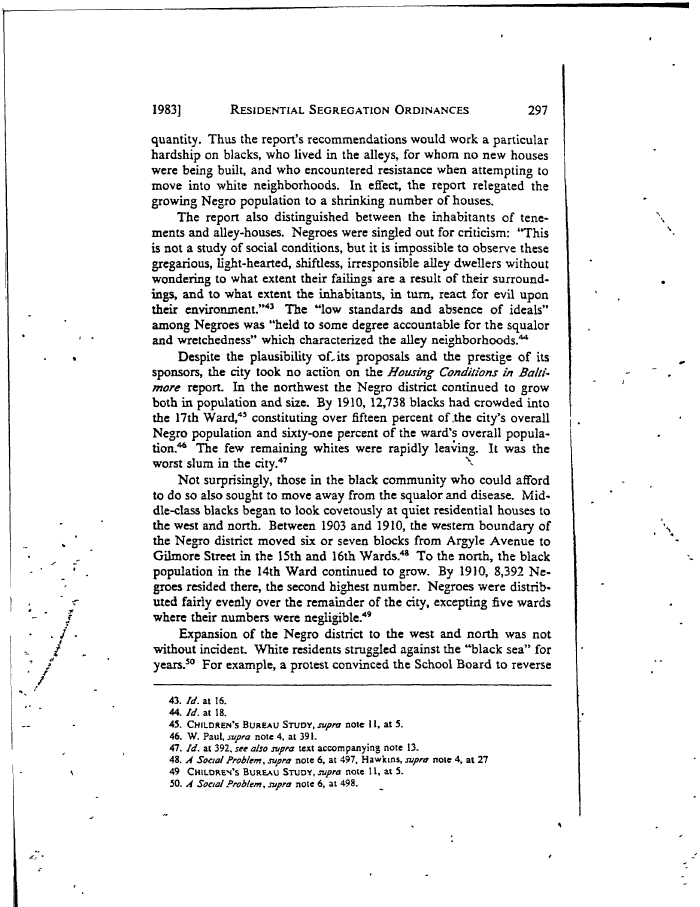 |
||||
|
Garrett Power, Apartheid Baltimore Style: The Residential Segregation Ordinances of 1910-1913, Maryland Law Review, 42 (1983) , Image No: 10 Enlarge and print image (62K) << PREVIOUS NEXT >> |
 |
||||
|
Garrett Power, Apartheid Baltimore Style: The Residential Segregation Ordinances of 1910-1913, Maryland Law Review, 42 (1983) , Image No: 10 Enlarge and print image (62K) << PREVIOUS NEXT >> |
| 1983] RESIDENTIAL SEGREGATION ORDINANCES 297 •» quantity. Thus the report's recommendations would work a particular hardship on blacks, who lived in the alleys, for whom no new houses were being built, and who encountered resistance when attempting to move into white neighborhoods. In effect, the report relegated the growing Negro population to a shrinking number of houses. The report also distinguished between the inhabitants of tene- ments and alley-houses. Negroes were singled out for criticism: 'This is not a study of social conditions, but it is impossible to observe these gregarious, light-hearted, shiftless, irresponsible alley dwellers without wondering to what extent their failings are a result of their surround- ings, and to what extent the inhabitants, in turn, react for evil upon their environment."43 The "low standards and absence of ideals" among Negroes was "held to some degree accountable for the squalor and wretchedness" which characterized the alley neighborhoods.44 Despite the plausibility of its proposals and the prestige of its sponsors, the city took no action on the Housing Conditions in Balti- more report. In the northwest the Negro district continued to grow both in population and size. By 1910, 12,738 blacks had crowded into the 17th Ward,45 constituting over fifteen percent of .the city's overall Negro population and sixty-one percent of the ward's overall popula- tion.46 The few remaining whites were rapidly leaving. It was the worst slum in the city.47 Not surprisingly, those in the black community who could afford to do so also sought to move away from the squalor and disease. Mid- dle-class blacks began to look covetously at quiet residential houses to the west and north. Between 1903 and 1910, the western boundary of the Negro district moved six or seven blocks from Argyle Avenue to Gilmore Street in the 15th and 16th Wards.48 To the north, the black population in the 14th Ward continued to grow. By 1910, 8,392 Ne- groes resided there, the second highest number. Negroes were distrib- uted fairly evenly over the remainder of the city, excepting five wards where their numbers were negligible.49 Expansion of the Negro district to the west and north was not without incident. White residents struggled against the "black sea" for years.50 For example, a protest convinced the School Board to reverse 43. Id. at 16. 44. Id. at 18. 45. CHILDREN'S BUREAU STUDY, supra note 11, at 5. 46. W. Paul, supra note 4, at 391. 47. Id. at 392, see also supra text accompanying note 13. 48. A Social Problem, supra note 6, at 497, Hawk ins, supra note 4, at 27 49 CHILDREN'S BUREAU STUDY, supra note 11, at 5. 50. A Social Problem, supra note 6, at 498. |